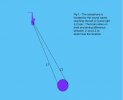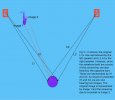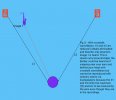Did you take these measurements using mics inside your ears? If so then the measurements in milliseconds were wrong.
Yes. this calibration should be based on the messurment from the ear microphone measurement.
That graph is only part of the calibration or correction. Messurement is fine. nothing wrong.
Interaural crosstalk cancellation deals with the errors happening within μs and not milliseconds. The longest possible interaural time delay between human ears is around 600 to 700 μs based on average human head size unless the head is over 1 meter diameter than milliseconds doesn’t apply for XTC. That itself could contribute to the graphs you are relying on.
Furthermore, you are referring to a single cancellation but XTC uses recursive signal where another delayed original signal would be launched by the same speaker to the intended ear by 2 times the delay of the inverted signal to the opposite ear. This process goes on till the attenuation is about 60dB. If I find time, I will attach a graph of RACE based XTC for comparison later.
Yes. I know. Same as the answer above. That's just part of the process. There's nothing wrong with the messurment, maybe is the semantics lost in my translation?
Here's an example of a response from one of the Few messurenets I have.
This is messurment by Ear-mic in Room. 4channel impulse recorded.
Let's summarize the words.
LL = Left ear listening to left speaker
LR= Right ear listening to left speaker
RL= Left ear listening to Right speaker
RR= Rightt ear listening to Right speaker
They are lagged by about almost 291us each.
I think misunderstood the graph I posted in another post as a generic FR.
And this graph is just part of that process.
What this graph represents is the residual that would be left if the response heard in the left ear from the left speaker (as in Bacch's example of bouncing both speakers alternately) was equalized so that it could be seen in the right ear from the left speaker.
It's not an effect in and of itself, but rather a paused view of the process in the middle of what's happening.
can see that the resulting response has the same timing as a traditional LR,RL impulse.
From here, it's just a matter of applying it and canceling it, the frequency and intensity of which will naturally vary from environment to environment, and there are limits.
So if we were to simulate what happens in real processing, un-pause and play again, it would look like this.
Align the Crosstalk extracted response on the right with invert polarity.
can also exclude roughly below 100Hz and above 8000Hz by applying a low cut/high cut. I didn't do this above, which is why the response fluctuates.
So when I looked at the example graph above and other people's messurements for different distances, I started to realize that the difference between LL/RR and LR/RL became unclear beyond a certain distance.
In practice, we didn't notice a significant difference in audibility with XTC, and our measurements didn't change much.
The reason for this was already shown in the graph above.
And a graph created for the same purpose.
I hope this conveys what I was trying to say.
How can an artist decides what is correct if he doesn’t know how it would sound with XTC. Does this mean all headphones listening is wrong because there is no crosstalk errors. If the artist really intended crosstalk the. He should first capture the sound with crosstalk do you know of any artist using microphones that can capture crosstalk? There is no crosstalk in the recording. It is the by product of what happens when we reproduce what was captured by the mics and certainly that not what the mics intended.
That's what I'm trying to say...
so I was wondering if some users might want to separate the intentions of XTC and the artist.
it's an oxymoron... =(
It was a joke that if you were following the artist's intentions with or without XTC's application, if you were listening at an unusual stereo distance, would that be ignoring the intentions. An irony and a joke!!! =(
I don't think so.
I'm not sure how the translation will reflect that, maybe if I write in short bursts it will translate well.
Stereo and XTC are nothing new.
Sometimes artist make mix binaurally.
XTC is not mysterious or new. It's just a doctor who fixes the errors in our listening.
It's a headache for all of us to talk about whether or not XTC should be applied and what the artist's intentions are.




